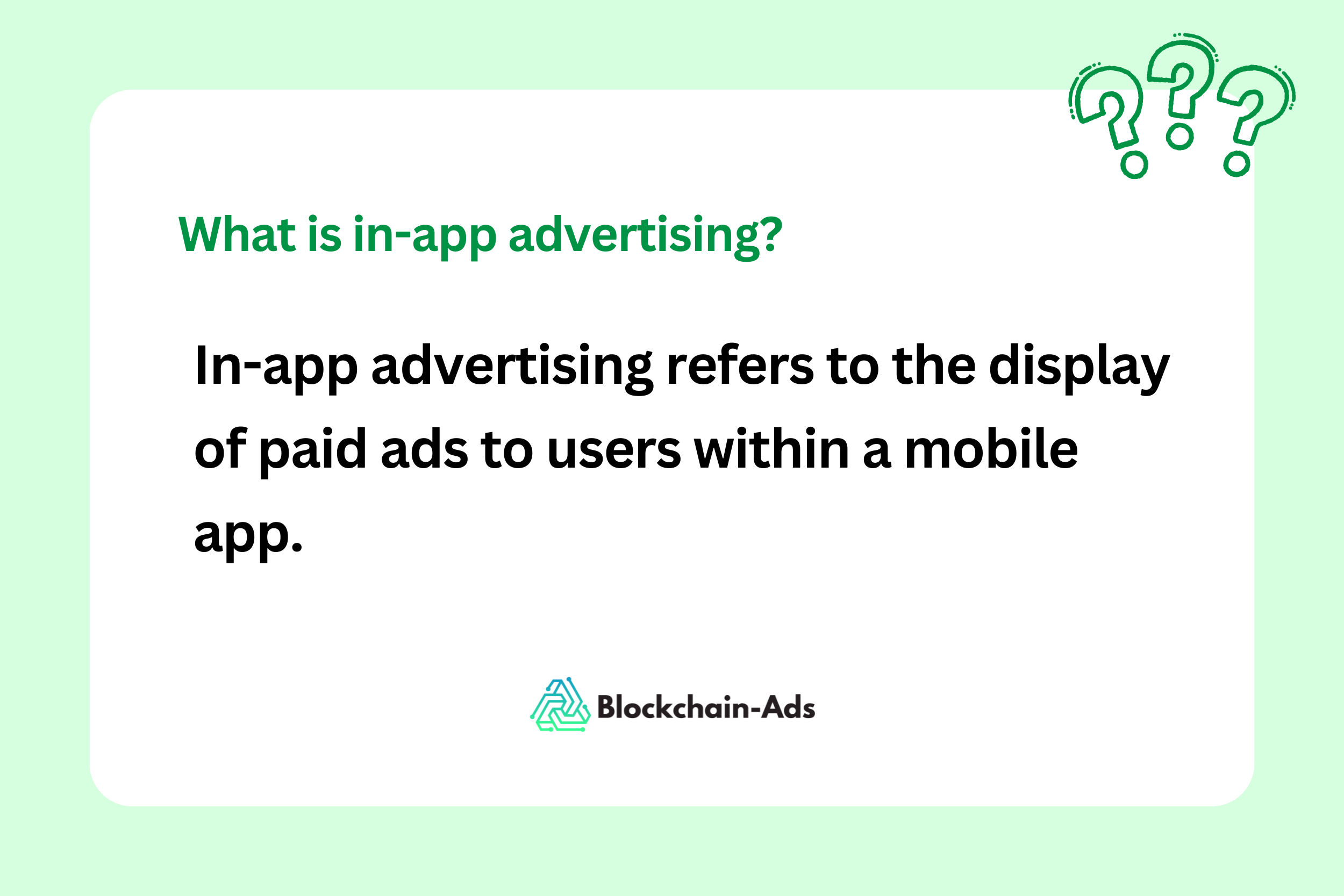インアプリ広告:仕組み、メリット、フォーマット、ターゲティング
インアプリ広告を使用して、ユーザーが使用するモバイルアプリ内で理想的なオーディエンスとつながることができます。モバイルデバイスの使用は大幅に増加しています。2025年末までに、74億9000万のモバイルユーザーが存在する可能性があります。広告主は、アプリ内のオーディエンスに広告を表示することで収益を上げるために、この市場を活用しています。
広告パブリッシャー向けの市場は収益性が高く、インアプリ広告の支出は2025年までに3,900億4000万ドルに達すると予想されています。ただし、インアプリ広告を計画する際は、GDPRおよびその他のプライバシー規則について考える必要があります。
インアプリ広告、さまざまなフォーマット、ターゲティング方法、およびその利点について見てみましょう。
インアプリ広告とは何ですか?

インアプリ広告とは、モバイルアプリ内でユーザーに有料広告を表示することを指します。これは開発者が広告主にスペースを販売することで、アプリケーションを収益化することを可能にする戦略です。
広告主は、認知度向上、視認性の改善、ユーザーからのコンバージョンの恩恵を受けます。
インアプリ広告を効果的にする要因は、高度にコンテキストに基づいたターゲティングとコンバージョンに焦点を当てたキャンペーンです。アプリ開発者は、広告ネットワークからSDK(ソフトウェア開発キット)をアプリに追加します。ユーザーがアプリや広告とやり取りすると、開発者は収益を得ます。
インアプリ広告には、以下を含むいくつかのフォーマットがあります:
- バナー広告
- インタースティシャル広告(コンテンツ間に表示される全画面広告)
- リワード動画広告(ユーザーが動画を視聴してアプリ内報酬を獲得する)
そして、さらに多くのオプションが利用可能です。アプリ開発者は、エンゲージメントを高め、ユーザーエクスペリエンスを向上させるために最適なタイプを選択できます。
インアプリ広告はどのように機能しますか?
インアプリ広告は、買い手と売り手という2つの主要な部分を持つ構造化されたシステムを使用しています。その中間では、広告インベントリの売り手と広告主の間のブローカーとして機能する広告ネットワークが存在します。ワークフローとやり取りは次のようになります:
- アプリ開発者は広告ネットワークに広告表示のリクエストを送信します。
- 広告ネットワークはアルゴリズムを使用して最も高い料金を支払う広告を特定し、ユーザーに表示します。
- ユーザーは、記録されるビュー、クリック、またはアプリ内アクションを通じて広告とやり取りします。
- やり取りは広告主に報告され、広告主はユーザーのアクションに基づいて収益を生成します。
- 収集されたすべての記録データも広告主に送信され、将来のキャンペーンを最適化するために使用されます。
この効率的な売買プロセスは、広告主と開発者の両方を等しく満足させます。広告主はターゲットオーディエンスにリーチしてエンゲージし、開発者はユーザーにコストをかけることなくお金を稼ぎます。
インアプリ広告がどのように機能するかを理解したところで、モバイルWeb広告との違いは次のとおりです。
インアプリ広告とモバイルWeb広告の違いは何ですか?
インアプリ広告とモバイルWeb広告の主な違いは、それらが表示される場所です。インアプリ広告はモバイルアプリに表示され、Web広告はブラウザに表示されます。インアプリ広告は通常、より良いトラッキングとパーソナライゼーションを備えています。これにより、多くの場合、より高いエンゲージメント率につながり、パフォーマンスベースのキャンペーンにより効果的になります。
ブランドにとってのインアプリ広告の利点は何ですか?
広告主が自社製品にインアプリ広告を選択する理由はいくつかあります。数百万のユーザーが常にモバイルデバイスを使用しており、アプリのパーソナライゼーション機能により、広告にとって生産性の高いチャネルとなっています。以下は、ブランドにとってのインアプリ広告の利点のリストです:
- 高いエンゲージメント率
- より良い視認性とCTR
- 精密ターゲティング
- ブランドセーフティと不正削減
高いエンゲージメント率
インアプリ広告によって提供される没入型体験は、より強いエンゲージメントを促進します。ユーザーはすでに特定のアプリエクスペリエンスにコミットしているため、広告主は類似の興味を使用してユーザーをキャプチャする可能性が高くなります。リワード動画広告の使用は、高いビュースルーコンバージョンを達成するのにも効果的です。
より良い視認性とCTR
インアプリ広告の視聴率は、インタースティシャル、プレイアブル、リッチメディアなどの没入型広告フォーマットにより、かなり高くなります。ユーザーは全画面広告や動画デモとやり取りする可能性が高くなります。これにより、特にMOFUおよびBOFUステージでより良いCTRが得られます。
精密ターゲティング
インアプリ広告の主な利点の1つは、モバイルアプリケーションで利用可能な機能です。これらは、ユーザーデータ、アプリ内アクション、デバイスモデル、およびセッションごとの消費者行動へのアクセスを提供します。これにより精密ターゲティングが可能になり、広告主はより費用効率的で高性能なキャンペーンのためにユーザーを正確にセグメント化できます。
ブランドセーフティと不正削減
App StoreやGoogle Play Storeのモバイルアプリケーションは、マーケットプレイスのガイドラインに準拠し、安全性について検証されています。この環境は、広告主が不正リスクなしでブランドを宣伝する安全な空間を提供します。AdMobなどの広告ネットワークも、クリーンな広告インベントリを確保するための不正防止ツールを組み込んでいます。
主なインアプリ広告フォーマットは何ですか?
インアプリ広告主が、アプリの環境、ユーザーの好み、キャンペーン目標に適合させるために使用できるいくつかのフォーマットがあります。目標が視認性と認知度を高めることか、コンバージョンを促進することかに関わらず、今日利用可能なインアプリ広告フォーマットは次のとおりです:
- バナー広告
- インタースティシャル広告
- リワード動画広告
- ネイティブインアプリ広告
- プレイアブル広告
- オファーウォール広告
- リッチメディア広告

バナー広告
バナー広告は、アプリケーション画面の上部または下部に長方形の表示ユニットとして表示されるインアプリ広告の一種です。静的またはアニメーション化されることができますが、注意散漫を避けるため常に非侵入的です。バナー広告は、より没入型のフォーマットと比較して高いクリックスルー率を享受しませんが、コスト効率的でシンプルです。
インタースティシャル広告
バナー広告とは異なり、インタースティシャル広告は全画面を占有するインアプリ広告フォーマットです。ゲームレベル間やアプリページの読み込み時など、アプリ内の移行ポイントで表示されます。全画面フォーマットにより高いエンゲージメントを実現しますが、ユーザーエクスペリエンスを妨げないよう正しくタイミングを合わせないと広告疲労を起こしやすくなります。
リワード動画広告
リワード動画広告は、広告を視聴したり、所定のアクションを実行したりするユーザーに報酬を与えるインアプリ広告の一種です。これらの報酬には、ゲーム内通貨、追加ライフ、またはロックされたレベルへのアクセスが含まれる場合があります。リワード動画広告は自発的なやり取りを奨励し、適切に統合されるとコンバージョンと保持を増加させることが示されています。
ネイティブインアプリ広告
モバイルアプリケーション内に表示されるネイティブ広告は、アプリのコンテンツとインターフェースとスムーズに調和します。アプリのレイアウト、デザイン、コンテキストを模倣することで、より邪魔にならず、より魅力的になります。ネイティブインアプリ広告は主にニュースやソーシャルアプリで使用され、コンテンツスタイルのプレゼンテーションがエンゲージメントとクリックスルーを奨励します。
プレイアブル広告
プレイアブル広告は、顧客がダウンロードする前に製品のデモを試すことを可能にするインタラクティブなインアプリ広告フォーマットです。ゲーム広告や推奨アプリであっても、この「試してから購入」体験は広告主にとって強力なマーケティングツールです。これによりやり取りが増加し、ユーザーが製品の使用感を得ることができます。
オファーウォール広告
オファーウォール広告は、アンケート、動画視聴、アプリダウンロードなどのオファーの壁を提示するインアプリ広告です。これは、収入を得ようとするアプリ開発者と広告主のための収益化戦略です。ユーザーは好みのオファーを選択し、元のアプリ体験を妨げることなく報酬を獲得します。
リッチメディア広告
リッチメディア広告は、オーディエンスを引き付けるためにインタラクティブでメディアリッチなクリエイティブを使用するインアプリ広告の一種です。ビデオ、オーディオ、またはアニメーションフォーマットでデザインでき、画面全体に拡張したり浮遊したりする場合があります。リッチメディア広告は認知度キャンペーンに理想的で、高いコンバージョン率につながる可能性があります。
インアプリ広告で利用可能なターゲティング機能は何ですか?
ユーザーと接続し、エンゲージしようとする広告主は、効率的なターゲティング方法を組み込むことで、精密にそれを行う必要があります。これらの機能は、モバイルアプリケーション内のユーザーデータの量と粒度により効率的です。利用可能なタイプは次のとおりです:
- 行動・興味ベースターゲティング:これは、パーソナライズされた広告を表示するために、アプリ内アクションと興味に基づいてユーザーをターゲットにします。
- デバイス・OSターゲティング:これは、デバイスモデル、オペレーティングシステム、画面解像度などの機能によってオーディエンスをフィルタリングします。
- 位置ベースターゲティング:これは、GPSとIPデータを使用して特定のエリアのユーザーに広告を表示します。
- コンテキストターゲティング:これは、広告をアプリのコンテンツに一致させ、プライバシー重視の設定で役立ちます。
- ウォレットターゲティング:これは、ブロックチェーンアプリのユーザーに焦点を当て、ウォレットアクティビティとオンチェーン資産に基づいてターゲティングします。
- リターゲティング:これは、興味を示したユーザーを再エンゲージし、購入やサインアップの完了を促すことを目的としています。
トップインアプリ広告プラットフォームは何ですか?
成功するインアプリ広告を実行するには、強力なターゲティングとパフォーマンス機能を備えたこれらのプラットフォームの1つを選択してください:
- Blockchain-Ads
- Google AdMob
- Unity Ads
- IronSource
- AppLovin
各プラットフォームは、その強みと機能において独特です。それぞれを際立たせる要因の内訳は次のとおりです:
Blockchain-Ads
Blockchain-Adsは、広告主がインアプリキャンペーンを向上させるのに役立つ柔軟な広告ネットワークです。このプラットフォームは、バナー、ネイティブ広告、動画などの様々な高インパクト広告フォーマットを提供します。すべての広告をリアルタイム分析で追跡し、ROIを向上させ、ユーザーベースを効果的に成長させます。Blockchain-AdsはGDPR準拠で、パーソナライズされた広告のためのプライバシーフレンドリーなオプションを提供します。
ターゲティング機能、価格モデル、実世界のパフォーマンス指標を探索したい場合は、詳細な分析のために詳細なBlockchain-Adsレビューをご確認ください。
Google AdMob
Google AdMobは、Google Ads エコシステムとのリンクにより、主要なインアプリ広告プラットフォームです。開発者は、動画、ディスプレイ、ネイティブ、インタースティシャル広告を使用してアプリを収益化できます。広告主は広大なオーディエンスへのアクセスを楽しみます。AdMobは、クロスチャネルキャンペーン管理をサポートし、高度なターゲティングオプションを提供します。また、自動メディエーションと詳細な分析も特徴です。さらに、Firebaseとの統合により、小規模および企業アプリに最適です。
収益ポテンシャル、メディエーション効率、広告品質での比較を学ぶために、包括的なGoogle AdMobレビューをお読みください。
Unity Ads
Unity Adsは、Unityエンジンを使用するモバイルゲーム開発者向けに構築されています。その主な利点は、プレイアブルおよびリワード動画広告での広告配置とユーザーエンゲージメントを制御できることです。さらに、Unity AdsにはUnity LevelPlay経由のインベントリビッディングが含まれ、インプレッションのリアルタイム競争を促進します。
プラットフォームの収益化の強み、開発者ツール、ベストユースケースを完全なUnity Adsレビューで発見してください。
IronSource
IronSourceは、フルスタック広告収益化プラットフォームです。アプリのARPDAUを向上させ、価値を最大化します。このプラットフォームは、セグメンテーションとメディエーションのためのツールを提供します。また、リッチメディアやインタースティシャルを含む高インパクト広告フォーマットもサポートします。さらに、IronSourceはリアルタイムパフォーマンストラッキングを提供します。この機能は、広告主がROIプラスのキャンペーンでユーザーベースを拡大するのに役立ちます。
メディエーション機能と分析ツールが実世界のキャンペーンでどのように機能するかを確認するには、詳細なIronSourceレビューをご覧ください。
AppLovin
AppLovinは強力な広告プラットフォームです。インアプリ広告を通じて14億人以上の日次アクティブユーザーと広告主を接続します。このプラットフォームには、AI駆動の広告エンジンがあります。AppLovinは、パーソナライズされた広告とプログラマティック取引所でのリアルタイム入札にアルゴリズムを使用します。広告主は、バナーやリワード動画を含む多くの広告フォーマットを使用できます。開発者は、収益化を向上させるためのMAXメディエーションツールから利益を得ます。
AI駆動の最適化、入札パフォーマンス、開発者の利点に関する洞察については、完全なAppLovinレビューをお読みください。
インアプリ広告の一般的な価格モデルは何ですか?
広告主への課金方法を決定するために、さまざまな価格モデルが利用可能です。各モデルは、キャンペーンの目標に合致し、特定のユーザーのやり取りを追跡します。以下に、最も一般的なインアプリ広告価格モデルをリストします:
- Cost Per Mille(CPM)は、ユーザーのやり取りに関係なく、広告の1,000インプレッションごとに広告主に請求するモデルです。
- Cost Per Click(CPC)は、ユーザーが広告をクリックした時にのみ広告主に課金します。
- Cost Per Install(CPI)は、広告をクリックまたは視聴した後にユーザーがアプリをインストールした時にのみ広告主が支払う価格モデルです。
- Cost Per Action(CPA)は、ユーザーが事前定義されたアクション(サインアップまたは購入)を実行した時にのみ課金されます。
- Cost Per View(CPV)は主に動画広告フォーマットで使用され、広告主は動画視聴に対して課金されます。
適切な価格モデルの選択は、広告主が目標に基づいて広告キャンペーンを最大化する機会を提供します。これは、認知度、検討、コンバージョン、またはリターゲティングの可能性があります。
インアプリ広告パフォーマンスの測定方法
インアプリキャンペーンのパフォーマンスを評価する能力は、すべての広告目標を達成するための礎です。ユーザージャーニーのあらゆる段階で異なる指標を追跡して、キャンペーン広告を最適化できます。インアプリ広告で測定する主要なパフォーマンス指標は次のとおりです:
- インプレッション数と視認性率は、広告の頻度とユーザーの画面に表示されたかどうかを評価します。
- クリックスルー率(CTR)は、広告を視聴した後にクリックするユーザーの割合を示します。
- インストール率/コンバージョン率は、広告とのやり取り後にインストールを完了したり、アクションを実行したりするユーザー数を追跡します。
- リテンション率は、指定された期間にわたってアプリとのエンゲージを継続するユーザー数を測定します。
- 広告費用対効果(ROAS)は、広告に費やした単位額ごとに生成される収益を計算します。
- 生涯価値(LTV)は、ユーザーがアプリを使用する限り、そのユーザーから期待される総収益を推定します。
一緒に追跡および分析されると、インアプリ広告パフォーマンス指標は、キャンペーンの進歩の正確な表現を提供します。広告主は、結果を使用して必要な箇所で調整を行ったり、成功した広告により多くのリソースを投入したりできます。
インアプリ広告の課題または欠点は何ですか?
インアプリ広告は、セグメントの主要プレイヤーに卓越した利点を提供します。しかし、それに伴う制限も無視できません。一般的な問題は、プライバシーとプラットフォームの変更、不正確な分析、トラッキングの困難を中心とする可能性があります。対処されないままにしておくと、これらの欠点は全体的な広告パフォーマンスに影響を与える可能性があります。インアプリ広告の主な課題は次のとおりです:
- トラッキングとアトリビューションの困難
- 測定の不正確性
- プライバシーとプラットフォームの変更
以下は、これらの課題がインアプリ広告にどのように影響するかの内訳です:
トラッキングとアトリビューションの困難
モバイルユーザーは、さまざまな理由でデバイスを変更する可能性があります。これにより、パフォーマンスの測定方法を制限するアトリビューションの困難につながる可能性があります。プライバシーとデータ共有規制も、ユーザーデータに依存するプラットフォームのトラッキング機能に影響します。
測定の不正確性
誤解を招くインアプリパフォーマンス指標は、誤ったクリック、制限されたインストール後データ、ボットアクティビティ、または水増しされたインプレッションから生成される可能性があります。これらにより、インアプリ広告での実際のユーザーエンゲージメントの分析が困難になります。
プライバシーとプラットフォームの変更
GDPRなどの進化するプライバシー法や、AppleのATTやGoogleのプライバシーサンドボックスなどのプラットフォーム制限により、ターゲティングがより複雑になっています。これにより、従来の広告配置形式からより文脈的で確率的なターゲティングへの変化が生じています。
インアプリ広告の代替手段は何ですか?
目標によって、広告主はキャンペーンとより良く一致する他の広告フォーマットの使用を検討する場合があります。以下は、代替手段のリストとインアプリ広告との比較です:
- インアプリ広告 vs. 動画広告
- インアプリ広告 vs. ディスプレイ広告
- インアプリ広告 vs. ネイティブ広告
- インアプリ広告 vs. モバイルWeb広告
- インアプリ広告 vs. プログラマティック広告
インアプリ広告 vs. 動画広告
この2つの違いは、インアプリ広告がモバイルアプリケーションに表示される一方で、動画広告はプラットフォーム間でサポートされることです。インアプリ広告は動画フォーマットで公開できますが、より広いオーディエンス向けのものと比較して、多くの場合短く、ユーザー重視です。
インアプリ広告 vs. ディスプレイ広告
ディスプレイ広告はデスクトップとモバイルのWebサイトに表示できる一方で、インアプリ広告はダウンロード可能なアプリに埋め込まれています。ディスプレイ広告はクロスプラットフォームキャンペーンにより多目的である可能性がありますが、インアプリ広告はより良い視認性とコンバージョン指標を享受します。
インアプリ広告 vs. ネイティブ広告
標準的なネイティブ広告は多くの場合ブラウザベースである一方で、インアプリ広告はアプリのUIに溶け込みます。両方とも非侵入的ですが、ネイティブ広告は目立つインアプリ広告と比較して、周囲のコンテンツと調和します。
インアプリ広告 vs. モバイルWeb広告
モバイルWeb広告はモバイルWebブラウザに表示される一方で、インアプリ広告はアプリのオペレーティングシステム用に構築されています。このアプリ固有のターゲティングは、主にSEOに依存するWebアプリと比較して、広告主により良い機会を提供します。
インアプリ広告 vs. プログラマティック広告
それらの違いは、インアプリ広告が配置環境に焦点を当てている一方で、プログラマティック広告が自動化された広告購入方法であることです。広告主はインアプリ広告のスペースをプログラマティックに購入できますが、これは他の広告フォーマットにも適用されます。
インアプリ広告の将来のトレンド
広告主と開発者が成長する市場の一部を獲得しようと争うため、インアプリ広告は急速に上昇する軌道にあります。予測では、年間成長率(CAGR 2025-2029)8.17%で、2029年までに5,339億2000万ドルの市場規模が期待されています。注目すべき主なトレンドは次のとおりです:
- AI駆動のパーソナライゼーション
- 行動ターゲティングよりもコンテキスト
- インアプリプログラマティック入札
AI駆動のパーソナライゼーション
AI技術の導入は、予想以上に速くデジタル空間を変革しています。AI駆動のパーソナライゼーションにより、インアプリ広告は広告主からの入力なしにより動的になります。これにより、ROASと効率の大幅な向上が実現されます。
行動ターゲティングよりもコンテキスト
プライベート規制の変更により、行動ターゲティングのためのピクセルとクッキーへの依存が徐々に段階的に廃止されています。新しいフロンティアは、世界中のすべての主要な広告地域でコンプライアンスを維持するために、コンテキストターゲティングのみに焦点を当てます。
インアプリプログラマティック入札
自動化されたプログラマティック広告は、複数のインベントリソース全体で広告を配置したい広告主の標準になりつつあります。これにより、広告プラットフォーム全体での効率が向上し、パブリッシャーのフィル率が増加し、よりスケーラブルな広告キャンペーンにつながります。
資格を取得してアクセスする ブロックチェーン広告
ロレム・イプサム・ドロール・サイト・アメット、コネクター
クイック定義

現在のパートナーの何人かと話してください
すべての成功事例を見る

1200万以上にリーチ
10,000以上のウェブサイトと37のブロックチェーンでWeb3ユーザーをエンゲージしました。






.png)
.avif)





